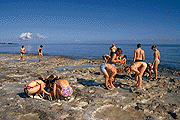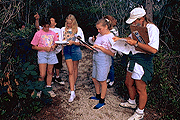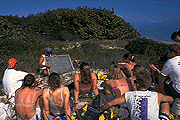

Beach
Studies

Nature
Hike

Island
Studies
© Copyright Seacamp Assoc. Inc. All Rights Reserved
OUR PROGRAMS - VAN TRIPS
CORAL ECOLOGY - NEARSHORE ECOLOGY - COASTAL
ECOLOGY
MARINE
INVESTIGATIONS - EVENING PROGRAMS
TRIPS WITH YOUR VAN-
HIKING, SNORKELING AND WADING
IN THE KEYS- DAYTIME OPTIONS
WITH YOUR TRANSPORTATION
Island Survey
Groups that bring a van have the
opportunity to see many of the unique ecological features of Big
Pine Key. Stops may include Watson's Hammock (tropical hardwood
hammock), the Cactus Hammock, the Blue Hole (freshwater hole with
alligators), Key Deer National Wildlife Refuge, pine/palmetto
woodlands and freshwater sloughs.
Sandy Beach Ecology
Bahia Honda State Park, five
miles east of Big Pine Key, has one of the few sandy beaches in the
Keys. Here students can snorkel, tidepool, and study beach and dune
vegetation. Older students can conduct a beach transect and
construct a beach profile.
Porites Shoal
Looe Key may be glamorous, but it is
seven miles offshore. Just off US Highway One are shoals of
non-reef-building coral that are equally as interesting. By
snorkeling over the finger coral Porites, students have a chance to
observe many species of fish.
Intertidal Ecology
At low tide, several areas
around Big Pine Key are perfect sites for tidepooling. Chitons,
limpets, nerites, urchins and sea hares abound in the limestone
pools. Stresses of life in this harsh environment are discussed.
Students also learn about geological features of the Keys.
Freshwater Resources Of Big Pine Key
The unique
geology of Big Pine Key permits the retention of rainwater
underground. This trip highlights the habitats that depend on this
freshwater such as pinelands, sloughs and the alligator hole. The
pipeline which supplies potable water to the Keys is studied as
well.